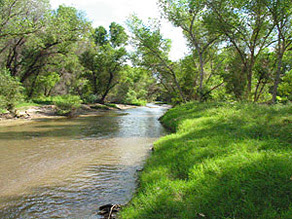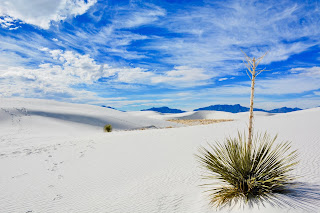 |
| The Santa Cruz River 2019 |
Many of the great cities of the world (London, New York, Paris) have rivers that run through them and are the throbbing hearts of their existence. Here in Tucson we also have a river,
the Santa Cruz, which holds enormous historical, cultural, environmental and identity value to Southern Arizona. However, its heartbeat is erratic at best. Some of the reasons for this are natural, while others echo problems that rivers face around the globe: overuse and a changing environment. The Santa Cruz also has to deal with the Mexico-US border, a man-made obstacle that our little river has to contend with just like its monster-sized, better known neighbors to the east and west – the Rio Grande and the Colorado rivers.
Quirky is an excellent adjective to use when describing the Santa Cruz. It is certainly fitting when one looks at how and where it flows during its 184 mile journey. It starts in southeastern Arizona and heads south into modern-day Mexico. Once there, it ambles around for about 12 miles and then makes a U-turn and heads north and back into the US. This route is one that many Americans generally take (go to Mexico, wander around and come right back), but it is unusual for a river. There are very few rivers that make a south to north U-turn and the Santa Cruz is the only river in the US to
cross the international border twice.
Here is a map that shows what it’s doing around the border.
 |
| A Hohokam canal incorporated into a "new" canal in 1907. |
Tucson is one of the longest
continually inhabited places in North America and, like other riverside cities and towns, it was the river that drew them here and nourished them. The
Hohokam were here 4,000 years before any Europeans and built massive and
sophisticated irrigation systems to harness the water of the Santa Cruz. Sometime between 1350 and 1450, the archaeological record of the Hohokam disappears; but their waterworks lived on and were cleaned out and used by others for hundreds of years. The
Tohono O’Odham of today are their descendants and they carry on the traditional stewardship of the land and water.
 |
| The White Dove of the Desert |
Starting in the first half of the 16th century,
Spanish Conquistadors began marching around Arizona looking for
lost cities of gold and other treasures. None of them stuck around, though; the landscape and natives being equally unfamiliar and hostile to them. It wasn’t until the last decade of the 1600s that an outsider came to stay,
Father Eusebio Francisco Kino. He established missions in the native settlements along the Santa Cruz at
Tumacácori and
San Xavier del Bac. The church at San Xavier was not completed until after Father Kino’s death but it stands as a breathtaking tribute to those who founded, worked and still work the mission. While the Tumacácori is now a national park, San Xavier remains a greatly treasured and carefully guarded part of everyday Tohono O’odham life.
And now back to the quirky factor: how Tucson was “founded” by an Irishman. In 1775, a Dublin-born man named
Hugh O’Conor rode into town. A Colonel in the Spanish army, Hugh was tasked with finding a suitable spot for a new outpost. He chose a spot under
Sentinel Peak that native people had inhabited for 1,000s of years and declared they would build a
presidio there. They did and the walls are still there - smack dab in the middle of downtown Tucson, which has made for some interesting time juxtaposition moments when researchers dig among office workers. His original proclamation still resides at the
National Archives of Mexico.
 |
| Silver Lake, Tucson 1888 |
Fast forward to the 1850s, when yet another set of newcomers decided to claim and change the habitat around the Santa Cruz. Virginians William and Alfred Rowlett build a dam downstream from Sentinel Peak. Known as Silver Lake, by the 1880s, this lake covered several acres and hosted numerous cultural and recreational activities. The family type entertainment value began to wane toward the end of the decade as a rougher element began to move in - this was, after all, the height of the cowboy-gunslinger era in the Southwest. A series of floods had damaged and, then completely wiped out, the dam by 1900. Today, on the corner of Silverlake and Mission roads, you can find the Pima County Jail.
 |
| An empty Santa Cruz |
 |
| Not a nuclear explosion, just a monsoon in AZ |
The turn of the century also meant a turn in the health of the Santa Cruz. By the 1940s, it had run dry due to overuse and, after that, the only time people would see water in it was during our monsoons.
Summer monsoons and the floods that come with them have always been a necessary and normal part of the life of the river. But, as more water has been diverted from it and natural drainage systems paved over, water has become a damaging force for the infrastructure of the river itself and the land and people around it. Water comes down hard, fills up the river quickly and drains out just as quickly. In between the coming down and draining out, a lot of damage can be done.
 |
| Tucson, October 1983 |
During the floods of 1983, a result of
Tropical Storm Octave, the Santa Cruz experienced the highest crest ever recorded. The sheer volume and power of the water caused 2-3 foot waves on the surface and splashed over bridges as it roiled by. Often called the “100-year flood”, this episode opened many people’s eyes to the fact that the dry riverbed they had become used to was in fact a dangerous river.
As demands on the river and climate change have kept the Santa Cruz dry, many people have fought valiantly to get the river and its ecosystem up and running again. Organizations such as
The Sonoran Institute (who ARBICO
donates to and supports),
Friends of the Santa Cruz and
The Santa Cruz River Heritage Project have made real progress. In June of this year, in a part of the river,
water began flowing again – for the first time in 70 years. Fish (including the
newly-released endangered Gila topminnow) and other
wildlife are now beginning to thrive in the river. There is a long way to go to bring back the past glory of the Santa Cruz, and it is probably not reasonable to expect that. But, our beloved river is still there and it looks like it will be beyond our lifetimes.
Submitted by Pam
































